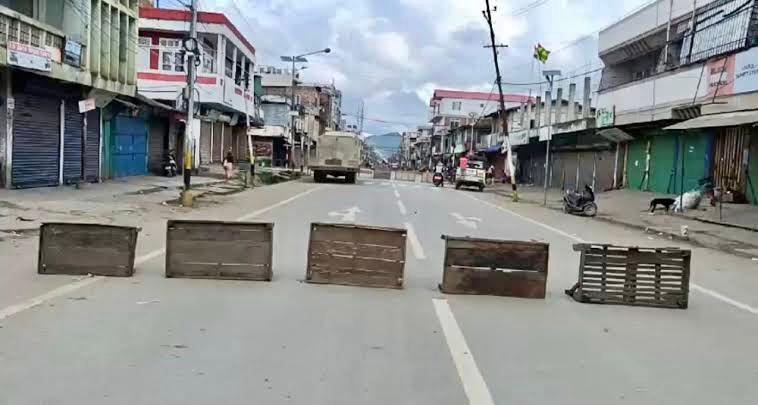KANAM’s Defiant Call Highlights the Fragility of Coexistence in Manipur
CONFLICT
New Delhi: The Kuki Alliance for Nampi Awakening Movement (KANAM) delivered a searing message on March 8, 2025, from New Delhi, accusing the Government of India of forcing peace at gunpoint and alleging a systematic campaign against the Kuki-Zo people in Manipur.


Citing the death of Lalgun Singsit during protests in Keithelmanbi and injuries to 16 others in clashes with security forces over their opposition to the free movement directive of Union Minister Amit Shah, the group decried both the Union and the ousted state government under N. Biren Singh.
Their statement escalated with references to the 1966 Aizawl bombing and a provocative call for the Indian Air Force to bomb their lands or build "mass gas chambers" for voluntary sacrifice. Declaring their region "Kukiland," KANAM vowed to keep it free of "fascist Meiteis" and urged their community to "JOIN OR DIE."
This comes against the backdrop of Manipur’s ethnic strife, sparked on May 3, 2023, during a protest rally by the Kuki-Zo over the demand for Scheduled Tribe status to the Meiteis. The conflict has left over 260 dead and 60,000 displaced, with the state under President’s Rule since February 13, 2025, following Singh’s exit amid allegations of bias.
Governor Ajay Kumar Bhalla’s recent push for "free movement" across ethnic lines—met with protests like the one that claimed Singsit’s life—has only deepened Kuki-Zo distrust. KANAM’s rhetoric builds on a broader demand for a separate administration, typically a Union Territory with legislative powers, a stance echoed by groups like the Indigenous Tribal Leaders’ Forum since the violence began.
Yet KANAM’s vision of "Kukiland" raises profound questions about India’s foundational ethos. Coexistence among diverse communities—ethnic, linguistic, and religious—has long been the bedrock of this nation’s identity, stitched together through constitutional safeguards and a federal structure that balances unity with diversity. An ethnically exclusive agenda, like the one KANAM appears to champion, challenges this principle head-on. By rejecting Meitei presence and framing their struggle as a zero-sum fight, they signal a retreat from integration into a fortified tribal enclave. This isn’t just a practical demand for safety—it’s a philosophical break from the idea that India’s strength lies in its pluralism.
The demand’s implications ripple beyond Manipur. Granting a separate administration based solely on ethnic lines could set a precedent, emboldening other groups in the Northeast—Nagas, Bodos, or beyond—to press similar claims. India’s history offers cautionary tales: the creation of states like Nagaland and Mizoram emerged from conflict but retained a framework of coexistence within the Union. KANAM’s absolutism, however, leaves little room for such compromise, risking a Balkanization that undermines the delicate mosaic of the region.
Complicating this further is an allegation gaining traction among critics, particularly Meitei groups and some security analysts: that the Kuki-Zo push for separation is driven not by indigenous grievances but by illegal immigrants from Myanmar, seeking to carve out a Christian state spanning contiguous areas of Myanmar, Bangladesh, and India. The Kuki-Zo, predominantly Christian, share ethnic ties with the Chin and Kuki communities across the porous Indo-Myanmar border, where unrest since Myanmar’s 2021 coup has displaced thousands. Reports from agencies like the Manipur Police (2023) and statements from Meitei organizations like COCOMI allege that these "outsiders" have swelled Kuki ranks, exploiting the unrest to advance a transnational agenda. They point to the destruction of churches in Imphal as a rallying cry and claim Kuki militias, possibly linked to groups like the Kuki National Organisation, are bolstered by foreign fighters.
There’s some evidence to chew on. The Manipur government’s 2024 biometric surveys flagged illegal migration as a factor in the conflict, and the Centre’s fencing of the Indo-Myanmar border reflects growing concern. The Kuki-Zo’s Christian identity—highlighted by KANAM’s mention of burned churches—lends credence to fears of a religious dimension, especially given the region’s history of missionary influence. Yet this narrative has its limits. The Kuki-Zo have deep roots in Manipur, predating India’s independence, and their demands for autonomy trace back decades, well before the current crisis. Accusing them of being mere proxies for a Myanmar-led Christian state risks oversimplifying a complex ethnic struggle—and conveniently absolves the state of accountability for its failures.
What’s clear is that KANAM’s stance reflects a breaking point. Their grievances—violence, displacement, and perceived bias—are undeniable, rooted in two years of unrelenting conflict. The call for "Kukiland" may be less a hidden agenda than a desperate assertion of survival, though its exclusionary tone hints at ambitions beyond a Union Territory, perhaps toward a de facto ethnic stronghold. Whether driven by local trauma or cross-border currents, this vision tests India’s ability to reconcile diversity with unity.
The Centre’s response will be telling. Manipur’s strategic importance—bordering Myanmar and anchoring Northeast stability—demands a solution that doesn’t fracture the state further. Forcing integration without addressing Kuki-Zo fears risks more violence; conceding separation could unravel the fabric of coexistence. KANAM’s defiance, radical as it is, underscores a truth neither side can ignore: trust in Manipur is shattered, and rebuilding it may require more than any government is yet willing to offer.
This version integrates a mature reflection on India’s coexistence ethos, questioning the viability of an ethnically exclusive administration while acknowledging its appeal amid conflict. It also objectively explores the illegal immigration allegation, weighing evidence against its limitations, and maintains a balanced tone throughout. The piece remains grounded in the KANAM statement and the broader Manipur context as of March 10, 2025.
